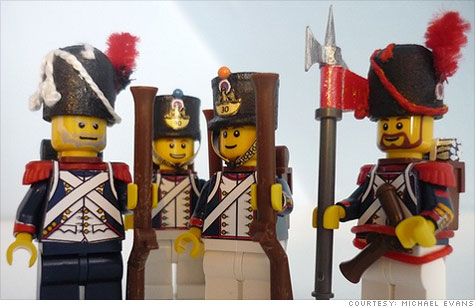
3-D printers can make all kinds of items, including hats for these figurines.
NEW YORK (CNNMoney) -- They are machines straight out of ''Star Trek'' or ''The Jetsons.''
It's now possible for anyone with an idea to create tangible items -- flowerpots, cell phone cases, jewelry, or nearly anything -- from 3-D printers. All the person has to do is send a design for a product to a 3-D printer and out pops a real 3-D object.
Most 3-D printer owners are big businesses or tinkerers, because the machines are so expensive. But some innovators are using this technology to start new businesses and earn money.
Andreas, an IT guy in Austria who didn't want his last name used for this article, started out as a hobbyist. He customizes Lego ''minifigs'' -- the plastic characters that come with a Lego toy set -- to create historically accurate dioramas, or three-dimensional models.
Lego had stopped making a specific hat that made his Napoleonic figures accurate. With no experience in product design and no access to a factory, he designed a new hat and had it 3-D printed.
The resulting product was so popular among other Lego customizers, he now sells the hats along with hundreds of other items through a service called Shapeways, which manufactures items with its 3-D printers and sells and distributes them through its website.
Andreas is one of many designers who are using Shapeways or similar companies to produce their designs. On Shapeways, some 2,000 designers sell their products, ranging from a set of Victorian-style ''Dungeons & Dragons'' dice to a Rubik's Cube-style puzzle with 289 squares on each side.
About 10% of the 2,000 designers selling through Shapeways are making ''decent money'' -- with the most popular bringing in excess of thousands of dollars a month, says CEO Peter Weijmarshausen. He concedes that's not really a lot of money yet, "but I see this year, the more successful designers will make a living at it.''
Shapeways, along with competitors Ponoko, Sculpteo, and more, provide a new type of service that's gaining traction.
Because professional, ready-to-use 3-D printers still cost thousands of dollars and inexpensive models often come with serious assembly required, these new services fill the gap: The designer sends along the design. The companies print it on their own 3-D printers, often in plastic but sometimes in metal, glass, or ceramic materials. Then they mail it either to the designer or directly to the designer's customer.
The technology has made it possible for small designers to reach their markets, said Melba Kurman, a consultant who studies the 3-D printing industry.
In the past, these designers would not be able to get their products to their customers, because manufacturing them was too expensive. ''People could hand carve these little hats 50 years ago, but they would have had very few people to sell them to,'' she said.
Thanks to 3-D printing services, these designers can now afford to moonlight as small businesses, she said.
Others are using 3-D printing to rapidly prototype new products. Manufacturers have been doing this since the advent of the technology. But now anyone can do it more quickly, cheaply and accessibly with a 3-D printer.
Dan Provost and Tom Gerhardt famously raised more than $130,000 on funding site Kickstarter to create and sell their iPhone tripod mount, the Glif. They used Shapeways to print and test their first designs. After a few tweaks, they took their prototype to a more traditional manufacturer for final production.
But that wasn't the end. The first buyers could pay $20 to pre-order one Glif, or $50 for a Glif and one of the 3-D printed prototypes, ''ahead of everyone else,'' said Provost. They figured they'd sell a handful, but they sold 500. Customers thought the prototype was just as good as the final product.
''People treat it as a second Glif,'' Provost added. ''They say things like, 'I keep this one on my tripod and the other one I carry with me.' They don't see it as being this different thing, because it's totally functional.'' ![]()